
Guests
- Lori Berensononce-imprisoned U.S. activist who has returned home from Peru after serving 20 years in prison and on parole for collaborating with the Túpac Amaru Revolutionary Movement.
The once-imprisoned U.S. activist Lori Berenson has returned home nearly two decades after being tried and convicted of collaborating with the Túpac Amaru Revolutionary Movement in Peru. Berenson is a former student at the Massachusetts Institute of Technology who left school to become an activist in the 1980s in El Salvador during the Reagan years and then moved on to Peru. In 1996, she was tried by a hooded military judge while prosecutors used secret evidence against her, and was ultimately convicted to a 20-year sentence. For three years, she was held in the frigid Yanamayo prison in the Andes mountains in an unheated, open-air cell without running water. After a major outcry, she was later transferred to the Socabaya prison in Arequipa, Peru. Berenson was released on parole in 2010 but was barred from leaving Peru for good until her sentence expired a few weeks ago. Democracy Now! was the first to interview Berenson in the Socabaya prison and broadcast her voice to the U.S. public after she was sentenced, and has long covered her case. She now joins us for her first television interview as a free woman back home.
Transcript
AMY GOODMAN: We end today’s show with Lori Berenson, the once-imprisoned U.S. activist who has returned home from Peru after nearly two decades. Berenson is a former student at the Massachusetts Institute of Technology who left school to become an activist in the ’80s in El Salvador during the Reagan years, then moved on to Peru. In ’96, she was convicted of collaborating with the Túpac Amaru Revolutionary Movement in Peru. She was tried by a hooded military judge. Prosecutors used secret evidence against her. For three years, she was held at the frigid Yanamayo prison in the Andes mountains in an unheated, open-air cell without running water. After a major outcry, she was transferred to the Socabaya prison in Arequipa, Peru. Lori Berenson was released on parole in 2010 but barred from leaving Peru for good until her sentence expired a few weeks ago. We are the first to interview Lori in the Socabaya prison when she was there in 1999 and now the first to have an extended interview with her when she came home. I talked to her last week and asked how it feels to be free.
LORI BERENSON: It’s wonderful to be here. I’ve been on parole for many years, which was similar to being free, but it’s nice to be completely free.
AMY GOODMAN: And to be back home in the United States for good.
LORI BERENSON: It’s nice to be with my family. It’s nice to see old friends. It’s nice to have the possibility of doing those things.
AMY GOODMAN: What brought a young woman who was a freshman at MIT first to Salvador and then to Peru?
LORI BERENSON: I decided that I was not in agreement with the type of academia work I’d be able—you know, you could, yeah, get a degree, and then you become part of the system. And I thought that becoming part of the system somehow—you know, I mean, other people are able to use that to—and to use it very well to the benefit of social justice, but others tend to be absorbed by the system. And I didn’t want to be part of—absorbed by the system. I also, you know, had a very different—at the time, I sort of started seeing that the world has a lot less to do with what you learn in school than what you learn in life, and that the meaning of degrees is—shouldn’t be that. So it was—in part, it was my way of saying, you know, I don’t believe in this type of system. On the other hand, I wanted to support processes that sought to change what at the time of this—this was when the U.S. was supporting death squads and supporting—you know, sending millions of dollars in military aid to bomb the civilian population in El Salvador. So that was the context in which I decided to get involved. It was a very different context than when I go to Peru, but it’s certainly in the case of El Salvador, that was a fundamental reason that brought me to that, was: How could my government, that talks about democracy, be doing this?
AMY GOODMAN: And so, you went to Peru. And how soon after you were in Peru that you were arrested?
LORI BERENSON: I was arrested a year later.
AMY GOODMAN: Explain what the MRTA was.
LORI BERENSON: The MRTA is an organization that basically followed the example of the guerrilla movements of the 1960s in Peru and the rest of the continent, really, the national liberation struggles. It forms out of different leftist organizations that actually were participating in the efforts to return to democracy in the early—the late '70s and early ’80s. And they form an alternative guerrilla movement to what is the better known, the Shining Path, which had emerged publicly in 1980. And it was a small organization, very similar to the organizations I am more familiar with in Central America. And when I got to Peru, I understood, in the case of the MRTA, they were also—it's an organization—at the time that I got there, there was nothing—no armed activities going on. And it was also an organization that seemed to be looking for a way out.
AMY GOODMAN: It was deemed a terrorist organization by Peru?
LORI BERENSON: Well, everything was called terrorism in Peru.
AMY GOODMAN: As well as the Shining Path.
LORI BERENSON: Yes, it was. Yes.
AMY GOODMAN: And by the United States.
LORI BERENSON: At the time, I presume so. There wasn’t a terrorist list. The terrorist list came out, I believe, in '98, if I'm not mistaken. But at the time of my arrival in Peru, it was not on any formal list.
AMY GOODMAN: What was it about the MRTA that you were drawn to, that got you involved?
LORI BERENSON: They were very similar to the organizations I had been familiar with in Central America. But more than that, it was my sense that they were in a very difficult situation, a lot of people in prison, and they were looking for a way out.
AMY GOODMAN: What do you mean, “a way out”?
LORI BERENSON: A way out—you know, in El Salvador, there was a peace process. In other countries, there—in Guatemala, there was a peace process, that, you know, there are moments in which you say, “OK, so how do we resolve the situation?” And it was a situation of dictatorship. So what do you do when you have an autocratic—or you want to call it dictator or autocratic government, that was not at all democratic? So, it wasn’t as if you could say, “Hey, we want to lay down our weapons and give ourselves in.” I think they were looking for a way to do that, to some—to some extent. I just—I didn’t realize it until after the embassy takeover, analyzing that, that that was how they were planning to find a way out, because when they took over the embassy, one of the things they talked about was national dialogue. You know, it was a way—I see it—you know, in retrospect, I think they were—that was the way out they were looking at.
AMY GOODMAN: Explain the government at the time.
LORI BERENSON: So, in 1990—well, Alberto Fujimori wins the elections of 1990 and applies shock—a shock program, you know, and applies a lot of dirty war tactics. There was a lot of intelligence used to carry out disappearances, in very selective disappearances, but, you know, talking about thousands of people were killed, and—during that period. And in 1992, he has a self-coup, where he closes Congress, he closes—restrictions on the press. It’s a series of, you know, lack of rights to protest. And that is the Peru I knew. So by the time I had gotten there, they had opened what they called—was it—the CCD. It was a—some form of congress. It was not the form that had always existed, but it was whatever they—whatever he’s invent—whatever he invented. And there were elections; however, it was still within the framework of a constitution that was not—you know, it was a neoliberalism, and it was not exactly democracy.
AMY GOODMAN: So let’s go back to November 30th, 1995. There are many people who are watching right now who were not even born then. So, talk about what happened, why you were arrested and what happened to you.
LORI BERENSON: OK, well, on that day, I was actually—in that time, I was doing some work in—as a journalist, and I was—I had gone to Congress. I was following a series of debates, actually a very important debate on narco houses or something, and I left—walking down the street, took a bus, and I was pulled off the bus and shoved into a car.
AMY GOODMAN: By?
LORI BERENSON: Un-uniformed policemen. And I was taken to a large office, which I later learned was the intelligence police office in [inaudible]—
AMY GOODMAN: The DINET?
LORI BERENSON: That was the DINCOTE. And I was—from there, I was taken to the house which I had helped rent a time earlier. And the shootout started. I was there all night when they were shooting—during the shootout, but I was in the police car.
AMY GOODMAN: The police held you in the car as a shootout took place—
LORI BERENSON: Oh, yeah.
AMY GOODMAN: —between the police and the MRTA—
LORI BERENSON: Yes, I was there. Yes, uh-huh.
AMY GOODMAN: —at the house that you had rented.
LORI BERENSON: And then I was—after that, I was detained. I was tried by a hooded military tribunal—that is, you know, not faced. Very limited access to legal protection. Lawyers were allowed in. They didn’t have access to the files. Statements were made under duress. There was a wounded woman who was forced to declare in a very difficult state. So, it was a difficult situation for all of those who were detained at the time. We were about 20-some-odd people at that time. And then I was sentenced to life in prison as a leader of the MRTA, which the—basically, the figure in—to be tried by a military tribunal was that if you weren’t detained in combat, then in order—you had to be a leader to be tried by a military tribunal. So they decided to call me a leader. So that was interesting.
AMY GOODMAN: When you were brought out to the press is this is the image Peruvians have of you, and anyone in the rest of the world, for the next few decades.
LORI BERENSON: Yes.
AMY GOODMAN: Explain what you were told as you were brought out to the press.
LORI BERENSON: OK, I was told that there was no microphone and that if I wanted to be heard, I had to raise my voice. And I guess at the time I didn’t think of the consequences. I mean, I think if I had said the same thing without looking angry saying it, they wouldn’t have been able to use it. But, you know, it’s the use of images. You take images from below, towards—above, people look very big. And you can always catch an image when someone has their mouth open. So, you know, having the mouth open is enough. Regardless of even if I spoke silently, you know, very quietly, if I had my mouth open, that would have been enough. But they were able to use that image for—’til now.
AMY GOODMAN: And you were told you had a very small amount of time, like a minute, to say whatever you needed to say?
LORI BERENSON: I believe so. I don’t remember that exactly.
AMY GOODMAN: What did you say?
LORI BERENSON: I said—
AMY GOODMAN: And you had to speak in Spanish, of course.
LORI BERENSON: OK. Well, I said that the MRTA wasn’t a—I didn’t think it was a terrorist organization. And I said that it was—if they existed, it was because there was a lot of injustice in the country, and saying basically that if I was going to have to pay for that, I would. And that’s what I did.
AMY GOODMAN: So, you were tried. Explain what this courtroom was like. What does it mean to be tried before a hooded judge?
LORI BERENSON: I don’t know if ours was similar to—I know of other cases that were actually rather different, but it was basically a three-phase trial. The first phase was you were interrogated by the police, and then at some point the military started intervening. It was very difficult to tell which was the difference at the time. You know, these are things that I might have seen differently if I had known more. But after that—that was the first phase—we were sentenced. We were all put in a room with hooded judges and hooded—surrounded by soldiers. We were given the sentences. And then we were given two—I believe two appeal trials in these rooms with distorted—I think one was in front of a judge, but there was—they tended to use these rooms with like distorted sound, so you’d be looking at a mirror. It was just sort of unusual to have distorted sound and images. And I think they filmed. And by the third, you know, sentence, they confirmed the life sentence. They changed some of the charges along the way, if I’m not mistaken. But it was—it was all preposterous. It was based really on I’m not sure what—a lot of imagination.
AMY GOODMAN: And what did they charge you with, and what were you convicted of?
LORI BERENSON: It was treason. I don’t really remember—as I said, I was first convicted of being a leader of the MRTA, so I don’t remember the exact charges. But they were—it was a long—it was a laundry list.
AMY GOODMAN: I wanted to go back for one moment to the time that I interviewed you in the Socabaya prison. This was back in 1999.
AMY GOODMAN: Did they present any evidence at the trial?
LORI BERENSON: No. In the actual trial? No, absolutely nothing.
AMY GOODMAN: Are you innocent of the charges?
LORI BERENSON: Yes, of the charges. Yes, I’m innocent of all the charges they’ve made against me.
AMY GOODMAN: Which brings us to the U.S. and what the U.S. is doing here around your case, the U.S. government. What is the U.S. doing? Are they helping you?
LORI BERENSON: There has been some pressure at certain times, but not heavy pressure. Not heavy enough pressure, at least, because I’m still here.
AMY GOODMAN: Do you think if they did put pressure, you wouldn’t be here? I mean, the U.S. administration?
LORI BERENSON: I mean, I think, in the sense of more than the Congress in itself. I mean, all the military aid they give them and that kind of support and the patting on the back of Fujimori every time that he does anything. I think he feels like he’s fine.
AMY GOODMAN: That was 1999. Can you describe that time in the Socabaya prison? You had been there—you had been imprisoned at that point for like three years, first at Yanamayo and then at the Socabaya prison.
LORI BERENSON: The thing with Socabaya, I think, if I’m not mistaken, the interview was when I was still in isolation, so I think it was difficult because I wasn’t allowed to talk to anyone. It was—you know, in that sense, it was—you know, we weren’t allowed access to the media. We weren’t allowed access to information. It was a very isolating experience. That is what I most remember about Socabaya, was that aspect.
AMY GOODMAN: And to people—of course, there have been millions of people imprisoned in the United States. But you now were imprisoned for about 15 years.
LORI BERENSON: Mm-hmm.
AMY GOODMAN: Can you talk to an American audience about what that experience meant?
LORI BERENSON: Well, I think it’s important, particularly in the United States, but it’s also important in Peru, the issue of prisons as a space of justice or as a space of punishment. I think we’d have a much healthier society if we used imprisonment sparingly, just so that people could learn from imprisonment and become—have an opportunity to become—to do something else or to learn—to learn to become productive—have the opportunity to be productive citizens. Unfortunately, in the United States and elsewhere, prisons are disproportionately—disproportionately with people of lower socioeconomic status. There’s race and class involved. It’s an issue in which you just see—it’s like social—it’s social struggle on lines. You know, there are a lot of kids who get into gangs because that’s the only option they see. And those kids could do other things if they had other options. So prisons could be a space in which that could happen. Or what usually happens is they just get thrown in, they get tortured, they get beat up on, and they—basically, if they’re not killed there, they’re not really—they don’t really have a chance. So when they get out, they don’t have a chance. So I don’t—what kind of world do we live in, in which we exclude people instead of trying to find ways to include them? I mean, you know, and so that happens—happens here, happens in Peru.
AMY GOODMAN: Dennis Jett is quoted as saying—he was the ambassador—
LORI BERENSON: Mm-hmm, yes.
AMY GOODMAN: —to Peru at the time—”What leverage do we have over Peru?” he asked. “I think this is a colonial, somewhat-racist mentality that these countries are always wrong, and all we have to do is apply pressure on any underdeveloped country.” He said, “There is no way anyone can look at her story,” referring to you, “and conclude anything other than she knowingly, willingly and enthusiastically worked for a terrorist organization.” That quote from just last week.
LORI BERENSON: Mm-hmm.
AMY GOODMAN: The ambassador at the time of your arrest in Peru.
LORI BERENSON: Mm-hmm.
AMY GOODMAN: Your response?
LORI BERENSON: Well, you know, he has been very consistent in his responses on this. I do not agree with him. I do not think there was overwhelming proof of anything that he says. But look, that’s his political position. It was not the position—not everyone was patting Fujimori on the back. He was. Not every—not all the ambassadors in Peru were doing that.
AMY GOODMAN: Ambassador Jett also demanded I be fired for having interviewed you in the prison. But your evaluation of Amnesty International saying something like 53 percent of the violence in the ’80s could be attributed to the Peruvian government, 46 percent of the killing to Shining Path, 1 percent to the MRTA?
LORI BERENSON: That’s—the Truth Commission came up with similar statistics. I think it’s really hard, because, first of all, I think the Truth Commission was developed as to start a process of memory and not to be the only thing that would come out, and it like closed the book. So, you know, their conclusion was actually that the Shining Path had committed 54 percent, and something like 35 percent to the state and 10 percent unknown, 1.5 percent to the MRTA, which seems a bit high, but that’s—it could be. I don’t know. I do think that if—you know, the problems with understanding what happens also depends on how and when you ask it. If you go to a community in which the military is still there, it’s highly probable they will not say the military did it. So, you know, those types of things, I think, will always be a problem when looking for truth. But I’m sure—you know, there have been horrific things have happened in Peru. And I think that’s why I say take responsibility for having collaborated with an organization that has committed crimes. I think that is—and that’s why I was in prison. So I think, you know, yes, it was secondary collaboration, I wasn’t involved in any specific act, but, yes, I do—I do take my responsibility. And I think those—at least in the case of the MRTA, all the leadership has taken responsibility for their acts. They are—that’s because it’s necessary. You know, that’s how—it’s like I said. It’s unfortunate that that is not happening on all sides.
AMY GOODMAN: I want to play a clip of your mother, Rhoda Berenson, and your father, Mark Berenson.
RHODA BERENSON: We’re asking everybody to remind President Bush what he said in March and to remind him he’s under an obligation: If a U.S. citizen is wrongfully held in another country, there’s a U.S. statute that says he must do everything in his power to release her. And the commission has essentially said Lori Berenson is wrongfully held.
MARK BERENSON: And this commission consists of seven respected internationally legal scholars and human rights scholars from seven different countries. President Bush, Lori is wrongfully held. It’s time now to show backbone and strength, and have the moral courage to do the right thing. If Ambassador Negroponte said a week ago that America takes care of its own, Lori Berenson is one of your own. She has suffered. She has been wronged. You know it. Secretary Powell knows it. Every person in this country of goodwill and understanding knows Lori Berenson has been wronged, and it’s time to bring her home.
AMY GOODMAN: What did that mean to you, the way your parents rallied around not only you, but rallied support in the United States, not only for your—around your imprisonment, but for the condition of people in Peru?
LORI BERENSON: I mean, I was very surprised. I just wasn’t—you know, I don’t come from a very political family. I didn’t expect their dedication. And to some extent, it was—I felt—I felt very badly for it. I still do, to a good extent. But I’m very grateful for it. They did an amazing—had amazing effort, despite the fact we didn’t have great communication. I think it was very difficult the first years for them, because they didn’t have access to a lot of information. They didn’t know what was really happening. And that made it—so, some of the confusions perhaps in the way they interpreted things has to do with the lack of communication. So I think they—despite that, they did an amazing—an amazing thing.
AMY GOODMAN: It’s 20 years later. You have been in Peru, basically—I don’t know if you call it under house arrest, but you were—you were not allowed to leave Peru from 2010 until now. And now you were just allowed to leave. Would you do things the same way, if we went back 20 years, but you know what you know now?
LORI BERENSON: Yes and no. I mean, when I go back to thinking like about education, if I had learned another skills, I might have been able to do some of the work I—maybe different types of work directly with populations, that would have made my life very different. In that sense, I think I would have chosen to learn a little more before going to do things, you know, learn a skill that would have been more useful. But in terms of doing it, I can’t go—I can’t deny my life. My life is what it was, or what it is. And I—I mean, yes, there are things that when I reflect upon what happened and say, you know, I—and that’s part of the reason why I take responsibility for my actions, and I apologize, because it’s like I do acknowledge that whether or not I am directly responsible for certain actions, there was horrific bloodshed in Peru, and I am very sorry it happened. So, in that sense, understanding how—if I had known I was going to come and symbolize that, I might have thought twice before speaking, because, you know, it’s hard to symbolize horror. But on the other hands, it’s like, you know, I wasn’t—the objectives of—certainly my own objectives and others’ objectives were not to create horrific bloodshed, either. They were—you know, they were to achieve a more just society. And like I said, I think it’s important that those who have been involved on any side take responsibility for what they have done. And most—you know, certainly on the side of the left, people paid, been in prison for a long time, and some are still there, whereas in the case of the government forces, they continue to live in entire, total impunity.
AMY GOODMAN: Although, interestingly, Alberto Fujimori, the president of Peru, is in jail. He used to wave your passport and say “feminista terrorista.”
LORI BERENSON: I didn’t know that.
AMY GOODMAN: He would carry it with him.
LORI BERENSON: Yeah.
AMY GOODMAN: But he ends up in jail.
LORI BERENSON: No, that is a bit ironic, yes.
AMY GOODMAN: So, let’s end with the issue of memory, something you’re very interested in, as you move forward in this country. What does it mean to you? And what does acknowledgment and understanding the past—what do you think has to happen?
LORI BERENSON: Well, I think in any country, and this includes the U.S., if we deny that things happened or try to paint it over as if it wasn’t that way, then the problems are more likely to either recur or at least just continue to be problems. If you start acknowledging them and say, “Hey, let’s get a handle on this. We’ve got to see where our—what the cause”—you know, the root cause of violence in Peru, it has to do with structural violence. I mean, you know, regardless of whoever started first—it’s not who started first. It’s like why on Earth would something—would the violence have been so extreme, had there not been the type of structural violence that existed in Peru? It was semi-feudal, in many ways, its production, but not just production. It has to do with the social system or racism, of exclusion, that existed into the 20th century. So, you know, that’s not unique to Peru, but I think in—I think what is told for—you know, should be told in general in the world is that, you know, it’s better if you look—if you look at things, you know, try to sit back and take a look at them, I think you could do much more than putting labels. When you put labels on people, you’re saying it’s the us-them. And when you say us-them, it’s dangerous, because it makes you think that you’re somehow superior to a them. And I think that’s one of the things that I really think came out in Peru, particularly in the case of my case and other people, is like you want the “them” label, because you can sort of—all of your guilt, you can sort of transfer to other people. And it’s like, that’s not useful. And you wind up having—you know, violence can escalate. It doesn’t—it’s not productive, doesn’t lead to anything.
AMY GOODMAN: That’s Lori Berenson, the once-imprisoned U.S. activist, home now after spending nearly two decades in prison and on parole in Peru. To see our coverage of Lori over the years, go to democracynow.org.

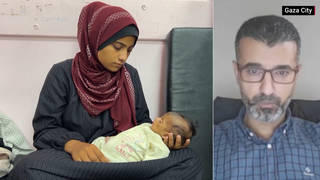
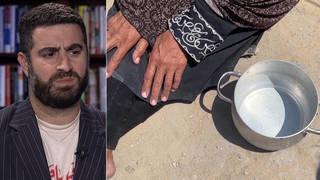
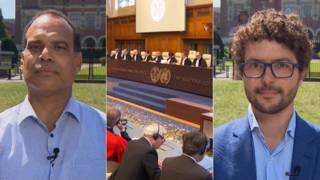
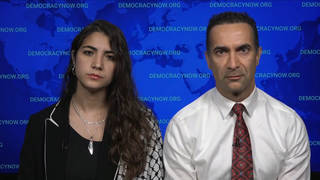
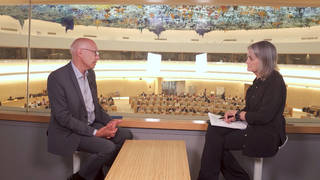
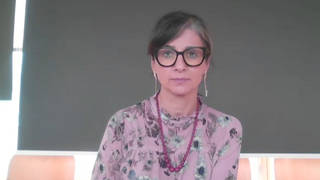
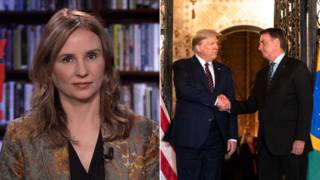
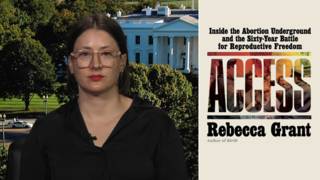

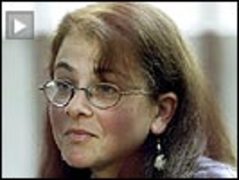

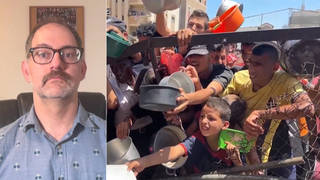
Media Options